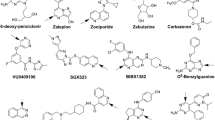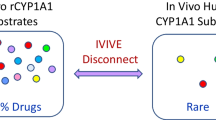Abstract
CYP3A is one of the most important cytochrome P450 isoforms responsible for drug metabolism by humans because it is the major such enzyme in critical tissues such as the gastrointestinal tract and liver, and it is involved in the oxidative biotransformation of numerous clinically useful therapeutic agents. Many factors regulate CYP3A expression but these are being increasingly defined so that the disposition characteristics of a drug whose metabolism is importantly mediated by this isoform can be reasonably well predicteda priori. For example, metabolic clearance is distributed within a population in a unimodal fashion but marked (5- to 20-fold) interindividual variability is present as a consequence of both genetic and nongenetic factors. In addition, firstpass metabolism occurs following oral drug administration and this may be extensive so that bioavailability is low. CYP3A activity can also be readily modulated by inducers like rifampicin and several anticonvulsant agents, and many potent inhibitors exist such as azole antifungal agents and macrolide antibiotics. Accordingly, the potential for drug interactions with these drugs as well as other CYP3A substrates, when given concomitantly, is high. Metabolism involving CYP3A is also likely to be affected by liver disease as well as aging, and modest differences may be present between men and women but these are often clinically unimportant. Because of such predictability, knowledge of the role and importance of CYP3A in the metabolism of a putative drug candidate is becoming increasingly desirable at an early stage in the development process.In vitro studies using human liver preparations, including microsomes, cultured hepatocytes and heterologous expressed enzymes, can provide important insights in this regard. This is particularly the case for identifying potential drug interactions whose clinical significance can be subsequently assessed. Data with respect to terfenadine and cyclosporine obtained several years after their approval and marketing, indicate that, if available and applied during their development, the paradigm of usingin vitro studies to rationally direct and prioritize clinical studies would have prospectively prevented the serious adverse effects and inefficacy that were only recognized during their empiric clinical use. Such examples, along with those associated with the genetic polymorphism of CYP2D6, provide strong justification for establishing the role and importance of individual CYP isoforms in a candidate drug's metabolism at an early stage.
Similar content being viewed by others
References
F. P. Guengerich. Human cytochrome P450 enzymes. In P. R. Ortiz de Montellano (ed.),Cytochrome P450: Structure, Mechanism, and Biochemistry, Plenum Press, New York, 1995, pp. 473–535.
S. A. Wrighton, M. VandenBranden, and B. J. Ring. The human drug metabolizing cytochromes P450.J. Pharmacokin. Biopharm. 24:461–473 (1996).
P. B. Watkins. Case studies—the gut.J. Pharmacokin. Biopharm. (in press).
E. R. Schuetz, J. D. Schuetz, W. M. Grogan, A. N. Fejes-Troth, G. Fejes-Troth, J. Raucy, P. Guezelian, K. Gionela, and C. O. Watlington, Expression of cytochrome P4503A in amphibian, rat and human kidney.Arch. Biochem. Biophys. 294:206–214 (1992).
F. P. Guengerich.In vitro techniques for studying drug metabolism.J. Pharmacokin. Biopharm. 24:521–533 (1996).
C.-Y. Wu, L. Z. Benet, M. F. Herbert, S. K. Gupta, M. Rowland, D. Y. Gomez, and V. J. Wacher. Differentiation of absorption and first-pass gut and hepatic metabolism in humans: Studies with cyclosporine.Clin. Pharmacol. Ther. 58:492–497 (1995).
K. E. Thummel, D. O'Shea, M. F. Paine, D. D. Shen, K. L. Lunze, J. D. Perkins, and G. R. Wilkinson. Oral first-pass elimination of midazolam involves both gastrointestinal and hepatic CYP3A-mediated metabolism.Clin. Pharmacol. Ther. 59:491–502 (1996).
D. Reimers and A. Ježek. Rifampicin und andere antituberkulotika bei gleichzeitiger oraler kontrazeption.Prax. Pneumol. 25:255–262 (1971).
D. Janz and D. Schmidt. Anti-epileptic drugs and failure of oral contraceptives.Lancet 1:1113 (1974).
D. G. Bailey, J. M. O. Arnold, and J. D. Spence. Grapefruit juice and drugs: How significant is the interaction?Clin. Pharmacokin. 26:91–98 (1994).
M. P. Ducharme, L. H. Warbasse, and D. J. Edwards. Disposition of intravenous and oral cyclosporine after administration with grapefruit juice.Clin. Pharmacol. Ther. 57:485–491 (1995).
H. H. T. Kupferschmidt, H. R. Ha, W. H. Ziegler, P. J. Meier, and S. Krähenbühl. Interaction between grapefruit juice and midazolam in humans.Clin. Pharmacol. Ther. 58:20–28 (1995).
R. Z. Harris, L. Z. Benet, and J. B. Schwartz. Gender effects in pharmacokinetics and pharmacodynamics.Drugs 50:222–239 (1995).
G. Castañeda-Hernández, C. Hoyo-Vadillo, J. A. Palma-Aguirre, and F. J. Flores-Murrieta. Pharmacokinetics of oral nifedipine in different populations.J. Clin. Pharmacol. 33:140–145 (1993).
A. Sowunmi, T. J. Rashid, O. O. Akinyinka, and A. G. Renwick. Ethnic differences in nifedipine kinetics: Comparisons between Nigerians, Caucasians and South Asians.Br. J. Clin. Pharmacol. 40:489–493 (1995).
C. C. Peck, R. A. Temple, and J. M. Collins. Understanding consequences of concurrent therapies.J. Am. Med. Assoc. 269:1550–1552 (1993).
D. A. Gartiez, R. H. Hook, B. J. Walker, and R. A. Okerholm. Pharmacokinetics and biotransformation studies of terfenadine in man.Arzneim Forsch. 32:1185–1190 (1982).
R. A. Okerholm, D. L. Weiner, R. H. Hook, B. J. Walker, G. A. Leeson, S. A. Biedenbach, M. J. Cawein, T. D. Dusebout, G. J. Wright, M. Myers, V. Schindler, and C. E. Cook. Bioavailability of terfenadine in man.Biopharm. Drug Dispos. 2: 185–190 (1981).
R. L. Woosley, Y. Chen, J. P. Freiman, and R. A. Gillis. Mechanism of the cardiotoxic actions of terfenadine.J. Am. Med. Assoc. 269:1532–1536 (1993).
T. K. Daneshmend and D. W. Warnock. Clinical pharmacokinetics of ketoconazole.Clin. Pharmacokin. 14:13–34 (1988).
P. K. Honig, D. C. Wortham, K. Zamani, D. P. Conner, J. C. Mullin, and L. R. Cantilena. Terfenadine-ketoconazole interaction: Pharmacokinetic and electrocardiographic consequences.J. Am. Med. Assoc. 269:1513–1518 (1993).
S. Pohjola-Sintonen, M. Viitasalo, L. Toivonen, and P. Neuvonen. Intraconazole prevents terfenadine metabolism and increase risk of torsades de pointes ventricular tachycardia.Eur. J. Clin. Pharmacol. 45:191–193 (1993).
P. K. Honig, D. C. Wortham, R. Hull, K. Zamani, J. E. Smith, and L. R. Cantilena. Intraconazole affects single-dose terfenadine pharmacokinetics and cardiac repolarization pharmacodynamics.J. Clin. Pharmacol. 33:1201–1206 (1993).
P. K. Honig, D. C. Wortham, K. Zamani, J. C. Mullin, D. P. Conner, and L. R. Cantilena. The effect of fluconazole on the steady-state pharmacokinetics and electrocardiographic pharmacodynamics of terfenadine in humans.Clin. Pharmacol. Ther. 53:630–636 (1993).
P. K. Honig, R. L. Woosley, K. Zamani, D. P. Conner, and L. R. Cantilena. Changes in the pharmacokinetics and electrocardiographic pharmacodynamics of terfenadine with concomitant administration of erythromycin.Clin. Pharmacol. Ther. 52:231–238 (1992).
P. K. Honig, D. C. Wortham, K. Zamani, and L. R. Cantilena. Comparison on the effect of the macrolide antibiotics erythromycin, clarithromycin and azithromycin on terfenadine steady-state pharmacokinetics and electrocardiographic parameters.Drug Invest. 7:148–156 (1994).
M. Eller, M. Stoltz, R. Okerholm, and B. McNutt. Effect of hepatic disease on terfenadine and terfenadine metabolite pharmacokinetics.Clin. Pharmacol. Ther. 53:162 (1994).
B. P. Monahan, C. L. Ferguson, E. S. Killeavy, B. K. Lloyd, J. Troy, and L. R. Cantilena. Torsades de pointes occurring in association with terfenadine use.J. Am. Med. Assoc. 264:2788–2790 (1990).
S. M. Tsunoda and F. T. Aweeka. The use of therapeutic drug monitoring to optimise immunosuppressive therapy.Clin. Pharmacokin. 30:107–140 (1996).
T. Kronbach, V. Fischer, and U. A. Meyer. Cyclosporine metabolism in human liver: Identification of a cytochrome P-450III gene family as the major cyclosporine-metabolizing enzyme explains interactions of cyclosporine with other drugs.Clin. Pharmacol. Ther. 43:630–635 (1988).
J. Combalbert, I. Fabre, G. Fabre, I. Dalet, J. Derancourt, J. P. Cano, and P. Maurel. Metabolism of cyclosporin A: IV. Purification and identification of the rifampicin-inducible human liver cytochrome P-450 (cyclosporin A oxidase) as a product of P450IIIA gene subfamily.Drug Metab. Dispos. 17:197–207 (1989).
G. C. Yee and T. R. McGuire. Pharmacokinetic drug interactions with cyclosporin.Clin. Pharmacokin. 19:319–332, 400–415 (1990).
L. Pichard, I. Fabre, G. Fabre, J. Domergue, B. S. Aubert, G. Mourad, and P. Maurel. Cyclosporin A drug interactions: Screening for inducers and inhibitors of cytochrome P-450 (cyclosporin A oxidase) in primary cultures of human hepatocytes and in liver microsomes.Drug Metab. Dispos. 18:595–606 (1990).
A. D. Rodrigues. Use ofin vitro human metabolism studies in drug development: An industrial perspective.Biochem. Pharmacol. 48:2147–2156 (1994).
P. Skett, C. Tyson, A. Guillouzo, and P. Maier. Report on the international workshop on the use of humanin vitro liver preparations to study drug metabolism in drug development.Biochem. Pharmacol. 50:280–285 (1995).
L. Z. Benet. The hypothesized preclinical use of drug metabolism isoforms.J. Pharmacokin. Biopharm. (in press).
R. L. Smith and R. R. Shah. Basic biochemical features and molecular genetics of CYP2D6.J. Pharmacokin. Biopharm. (in press).
P. B. Watkins. Noninvasive tests of CYP3A enzymes.Pharmacogenetics 4:171–184 (1994).
Author information
Authors and Affiliations
Additional information
Supported in part by grant GM31304 from the U.S. Public Health Service.
Rights and permissions
About this article
Cite this article
Wilkinson, G.R. Cytochrome P4503A (CYP3A) metabolism: Prediction ofIn Vivo activity in humans. Journal of Pharmacokinetics and Biopharmaceutics 24, 475–490 (1996). https://doi.org/10.1007/BF02353475
Published:
Issue Date:
DOI: https://doi.org/10.1007/BF02353475




